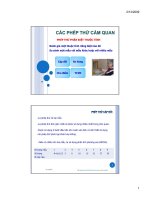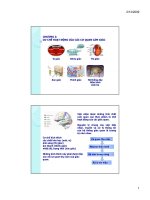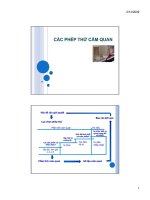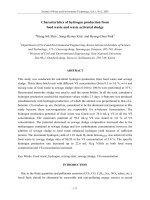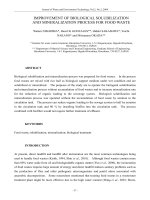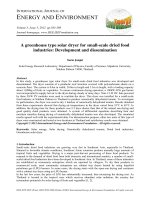Food spoilage
Bạn đang xem bản rút gọn của tài liệu. Xem và tải ngay bản đầy đủ của tài liệu tại đây (289.17 KB, 52 trang )
Food spoilage
Definition
n
n
n
Food spoilage can be defined
as a disagreeable change in a
food's normal state.
NOT acceptable for human
consumption and for food
industrial usage
Such changes can be detected
by smell, taste, touch, or sight
(disgusting).
n
Food safety ↔ food quality
Classifications of food spoilage
n
Stable or non perishable foods (sugar, flour,
dry beans)
n
Semi perishable foods Foods handled and
stored properly → remain unspoiled for long
period (potatoes, apples)
n
Perishable foods Spoil readily without special
preservative methods (fish, meat, eggs, milk)
Main causes of food spoilage
q
Physical changes
n
n
q
aw, temperature, mechanical effects
Caused by the inappropriate transport, handling and storage
Biological factors
n
Microbiological
q
n
Macrobiological
q
q
bacteria, yeasts, moulds (most common)
rodents, insects, birds, parasites
Chemical, biochemical factors
n
n
non-microbial or enzymatic changes usually involving
oxygen → oxidation processes (e.g., rancidity of fats and oils)
activity of endogenous tissue enzymes (food of vegetable or
animal origin)
Consequences/effects
of food spoilage
q
changes in nutritional value
n
q
changes in organoleptic features
n
q
Decomposition of proteins, carbohydrates,
vitamins
colour, flavour, taste, consistency →
mucilaginous surface, unpleasant odour,
unwholesome effects
n
n
n
Biogenic amines, toxins,
Metabolites of microorganisms
Pathogen microbes
Sources of microbial spoilage
n
Ubiquiter microorganisms
q
n
Can originate from: natural
habitat of microorganisms;
e.g. soil, water, air,
Special sources
contamination
q
q
q
q
Spoiled raw materials
Food waste
Biofilm on the surface of
equipments
Human → personal hygiene
Ubiquiter microorganisms
• natural habitat of microorganisms is the soil
(except for pathogen bacteria)
• Way of contamination of animals and plants can
be direct from soil or indirect by water or air
• Related microorganisms:
– Gram (-): Pseudomonas, Acinetobacter, Alcaligenes,
Enterobacter spp.;
– Gram (+): Micrococcus, Arthrobacter, Streptomyces
spp.;
– Aerobic and anaerobic sporoforms: Bacillus,
Clostridium
Ubiquiter microorganisms
• Microorganisms can contaminate the surface of
plant or fur and skin of animals
• These are not harmful for plants or animals, but after
harvesting or slaughtering can cause spoilage during
storage of products (Micrococcus, Lactobacillus
spp.).
• Meat products also can be contaminated by
microorganisms from mouth (Streptococcus spp.) or
from the gastrointestinal tract (Bacteroides,
Eubacterium, Clostridium spp)
Special sources contamination
• Surfaces of equipment, instruments, utensils, the
wall and floor surfaces,
– Inappropriate hygiene of plant → Food waste → resulting a
specified, adapted micro-flora typical to plant and products
• Spoiled raw material
– Plant: mechanical lesions during the harvesting, transport
can enhance the penetration of microbes into the deeper
tissues
– Animal: contaminated mainly during slaughter
• Rodents, insects (fly, fruit fly, bee, wasp) can
contaminate the products during storage and
processing
Characteristic of
microorganisms
• Reproductive potential
– Among optimal circumstances the fastest
– The fastest growing microbe becomes dominant
(mainly bacteria, but …)
• Metabolism, nutrient requirements
– Substrate → metabolism in cells → metabolites
(useful or harmful)
– The process is influenced by the environment
(presence/absence of oxygen, available nutrients)
Factors affecting microbial spoilage
n
n
n
Intrinsic factors of foodstuffs
q Physical-chemical properties: aw,
redox circumstances, pH,
q Chemical composition: Nutrient
materials, vitamins, inhibitors
q Biological structure
Extrinsic factors of foodstuffs
q Temperature, humidity, atmosphere
composition
q Processing effects
q Hygiene, cleaning, disinfections
Implicit parameters
q Interactions of microorganisms
q Reproductive potential
•
Intrinsic factors – water
Water content
of foods is quite high:
activity
– Meat, egg: > 70%
– Milk, fruits, vegetables: >80%
• For microbes only the free water is available (free
water content is characterized by the aw)
• The minimal aw is the limit to microorganisms for
growth/reproduction
– Bacteria: highest water requirement (>0.91aw)
– Yeasts: water requirement is lower than the bacteria
(≥0.88aw)
– Moulds: low water requirement (>0.78aw)
Minimum water activity requirement
of microorganisms
Group of microorganisms
Minimum aw of growth
_______________________________________________________
Most Gram-negative bacteria
0.97
Most Gram-positive bacteria
0.90
Halophilic bacteria
0.75
Most yeasts
Osmophilic yeasts
0.88
0.62
Most filamentous fungi
0.80
Xerotolerant fungi
0.71
Xerophilic fungi
0.61
Xeromyces bisporus
0.60
_______________________________________________________
Water activity of some foods
Food
Fresh vegetables, meat, milk, fish
Cooked meat, bread
Cured meats, ham, cheese
Dry cheese, salami
Flour, rice, beans, cereals
Jams
Dried fruits, caramels
Spices, milk powder
aw
0.98<
0.95 – 0.98
0.91 – 0.95
0.87 – 0.91
0.80 – 0.87
0.75 – 0.80
0.60 – 0.75
0.20 – 0.60
Intrinsic factors
n
n
water activity „tolerance”: aw=0,7 → food is
sufficiently protected from spoilage
Microorganisms growing in the food change the
level of available moisture by release of metabolic
water
q
moulds can destruct the tissues → water available to
yeasts and bacteria
Intrinsic factors – water activity
• If we want to ensure the safe storage life the aw has to
be reduced under 0.7
• Water content of dried foods belonging to aw of 0.7:
Food
Maximal water content %
Milk powder (whole)
Skim milk powder
7-10
10
Cocoa
7-10
Dried meat, fish
10
Dried whole egg
10
Dried/dehydrated vegetables
Dehydrated stock
12-22
13-21
Dehydrated fruits
18-25
Factors affecting microbial spoilage
Intrinsic factors of foodstuffs
Physical-chemical properties: aw,
redox circumstances, pH,
Chemical composition: Nutrient
materials, vitamins, inhibitors
Biological structure
Extrinsic factors of foodstuffs
Temperature, humidity, atmosphere
composition
Processing effects
Hygiene, cleaning, disinfections
Implicit parameters
Interactions of microorganisms
Reproductive potential
Factors affecting the moisture/water
requirements of organisms
n
n
n
n
n
Nutritive properties of the substrate
pH
Content of inhibitory substances
Availability of free oxygen
Temperature
Influence of aw on the growth and toxinproduction of moulds
Min. aw
Mycotoxin
Microbes
Growth
Toxinproduction
Aspergillus flavus
0,78-0,84
0,83-0,87
Ochratoxin
Aspergillus ocraceus
Penicillium cyclopium
0,77
0,82-0,85
0,85
0,87-0,90
Patulin
Penicillium expansum,
0,81
0,95
Aphlatoxin
Factors affecting microbial spoilage
n
n
n
Intrinsic factors of foodstuffs
q Physical-chemical properties: aw, redox
circumstances, pH,
q Chemical composition: Nutrient materials, vitamins,
inhibitors
q Biological structure
Extrinsic factors of foodstuffs
q Temperature, humidity, atmosphere composition
q Processing effects
q Hygiene, cleaning, disinfections
Implicit parameters
q Interactions of microorganisms
q Reproductive potential
